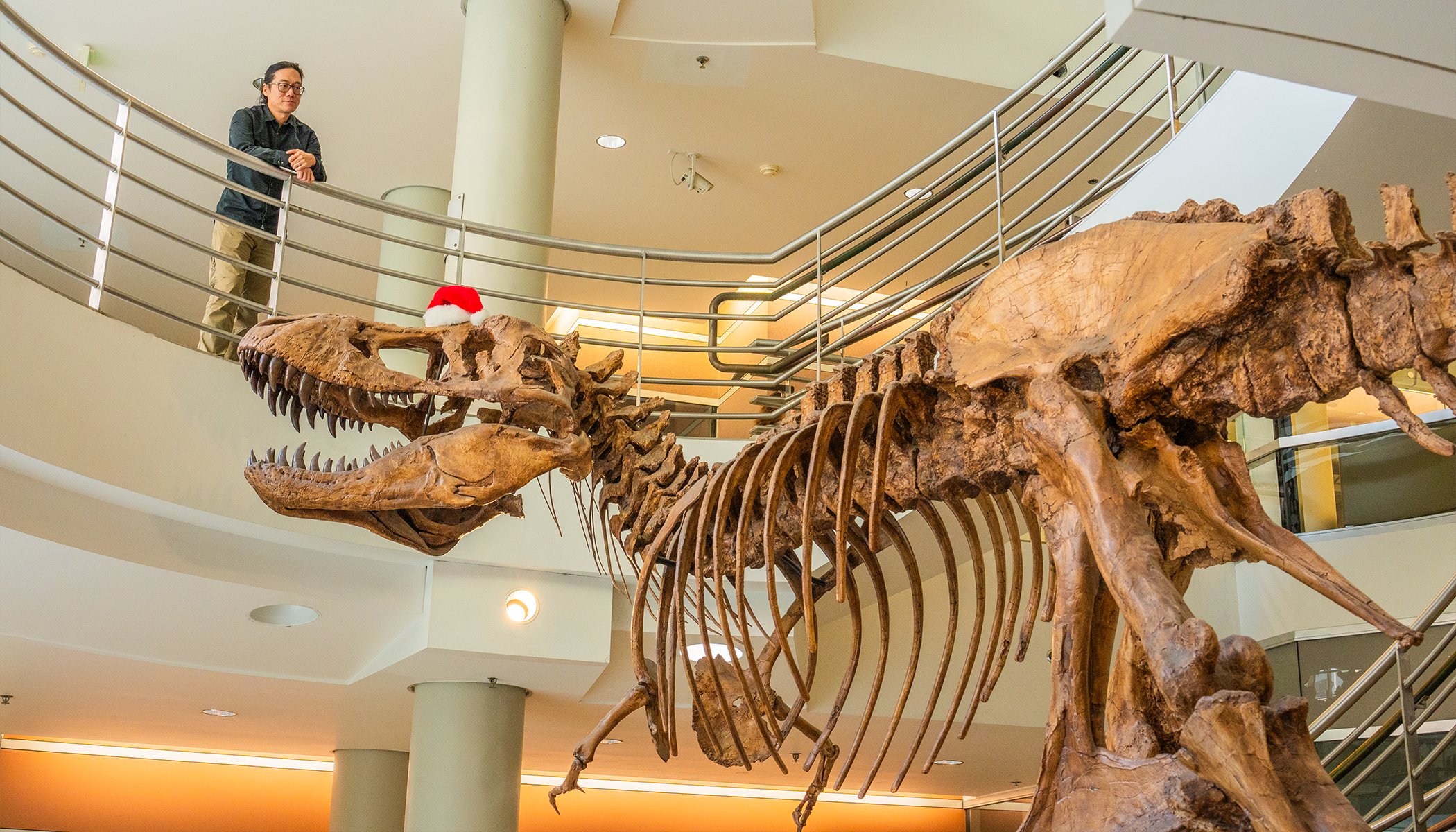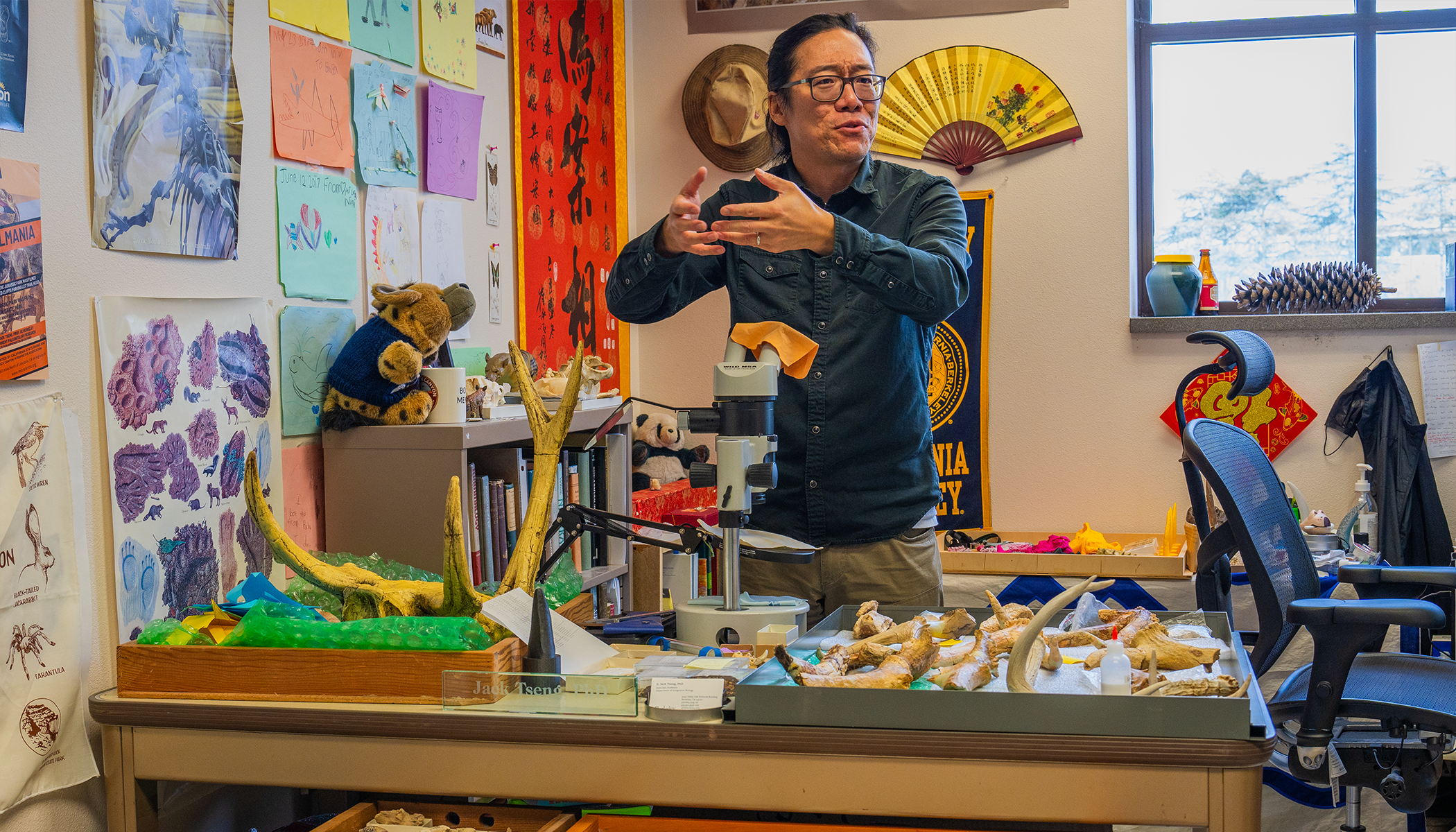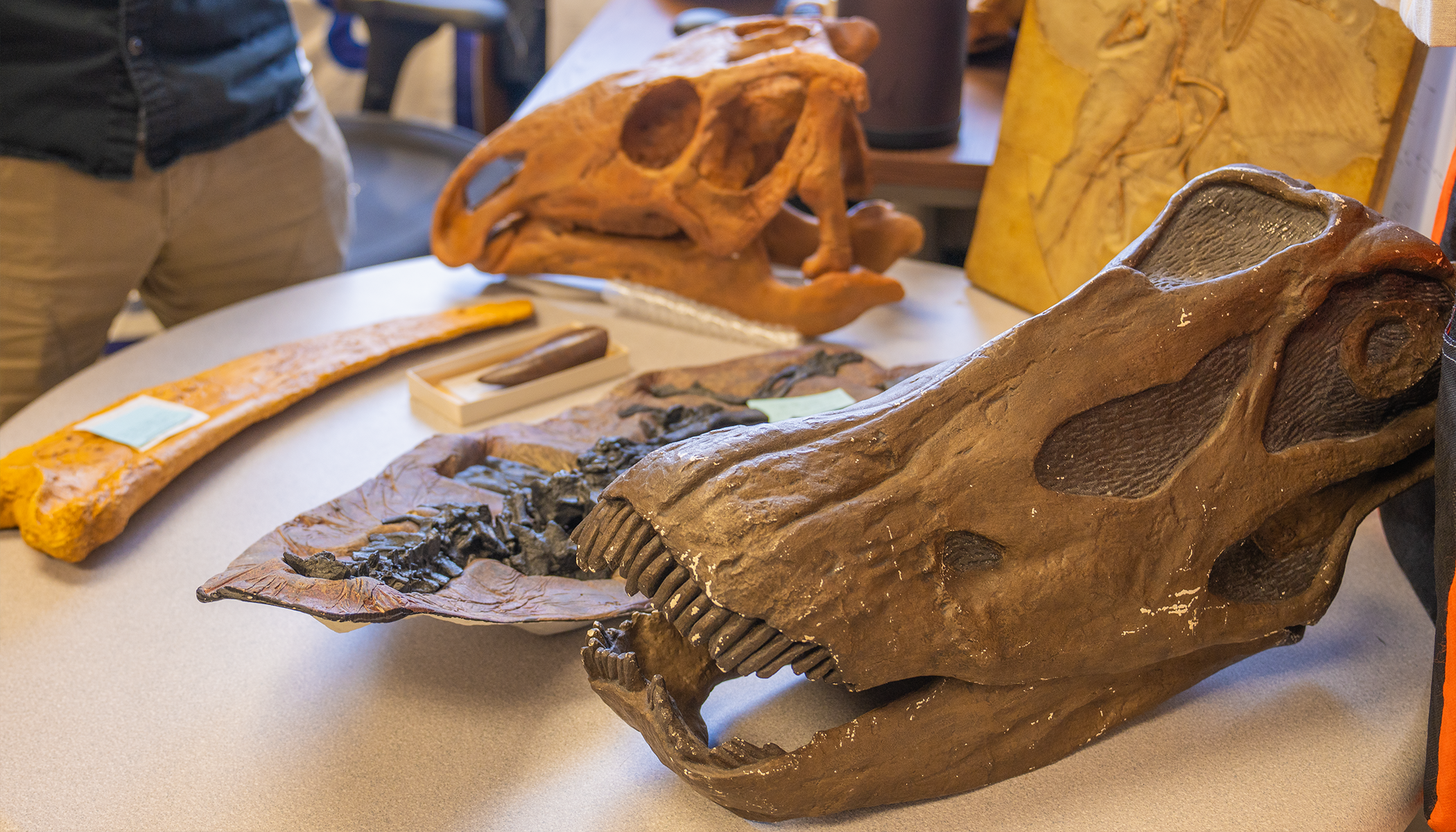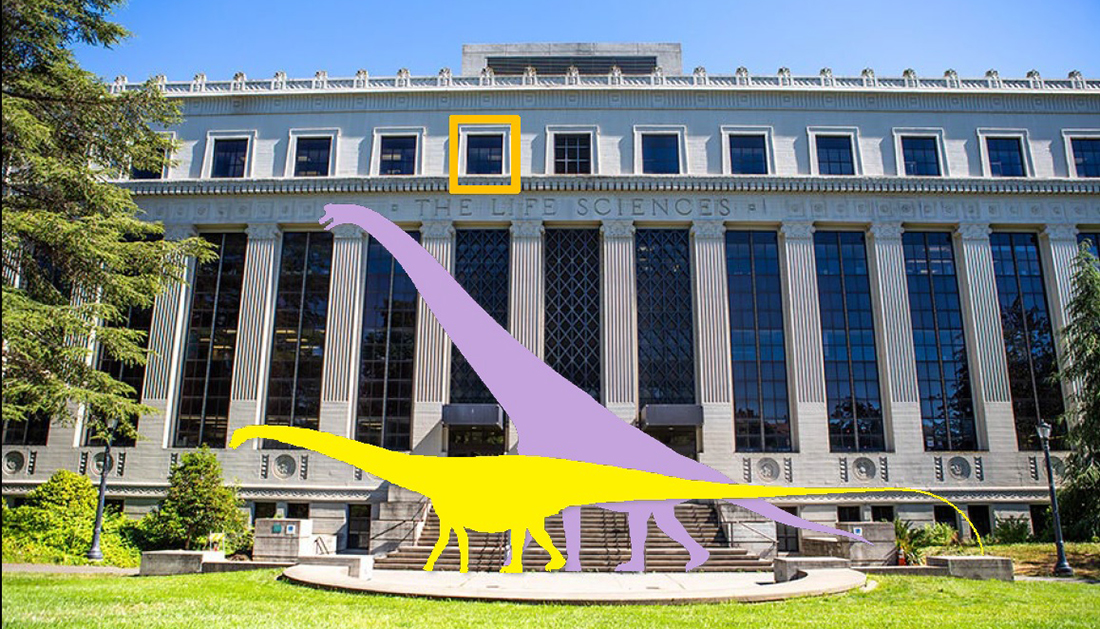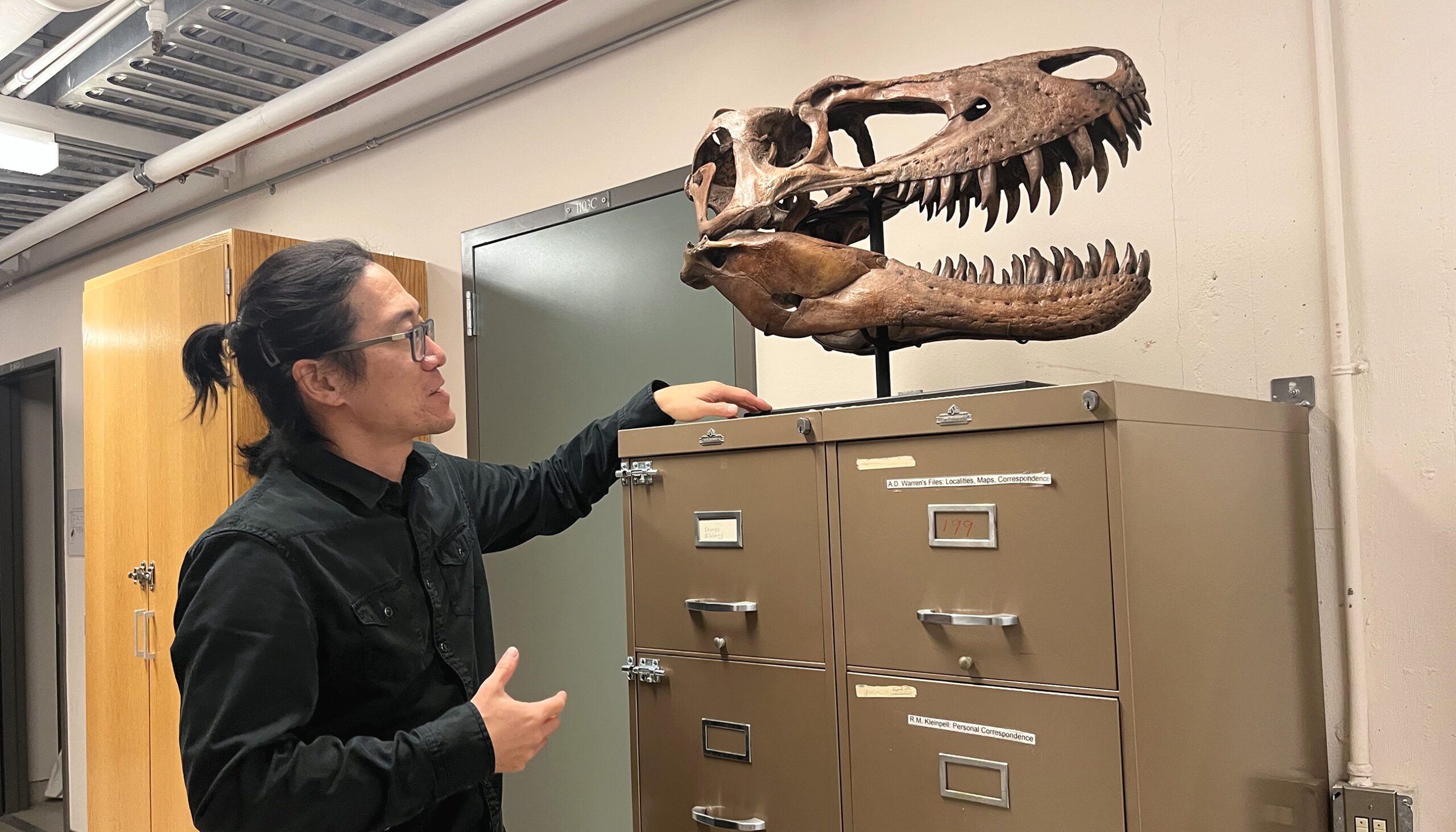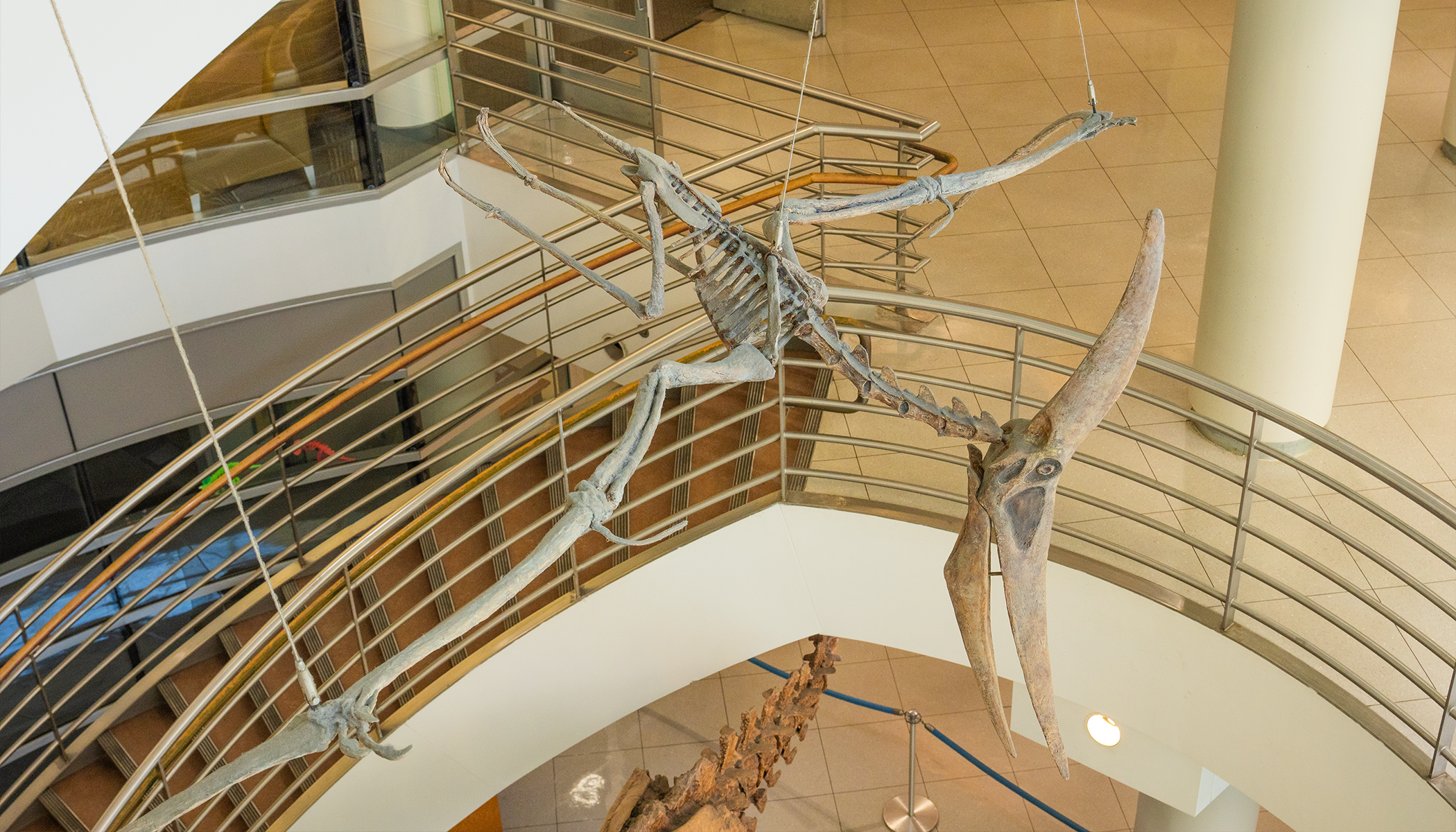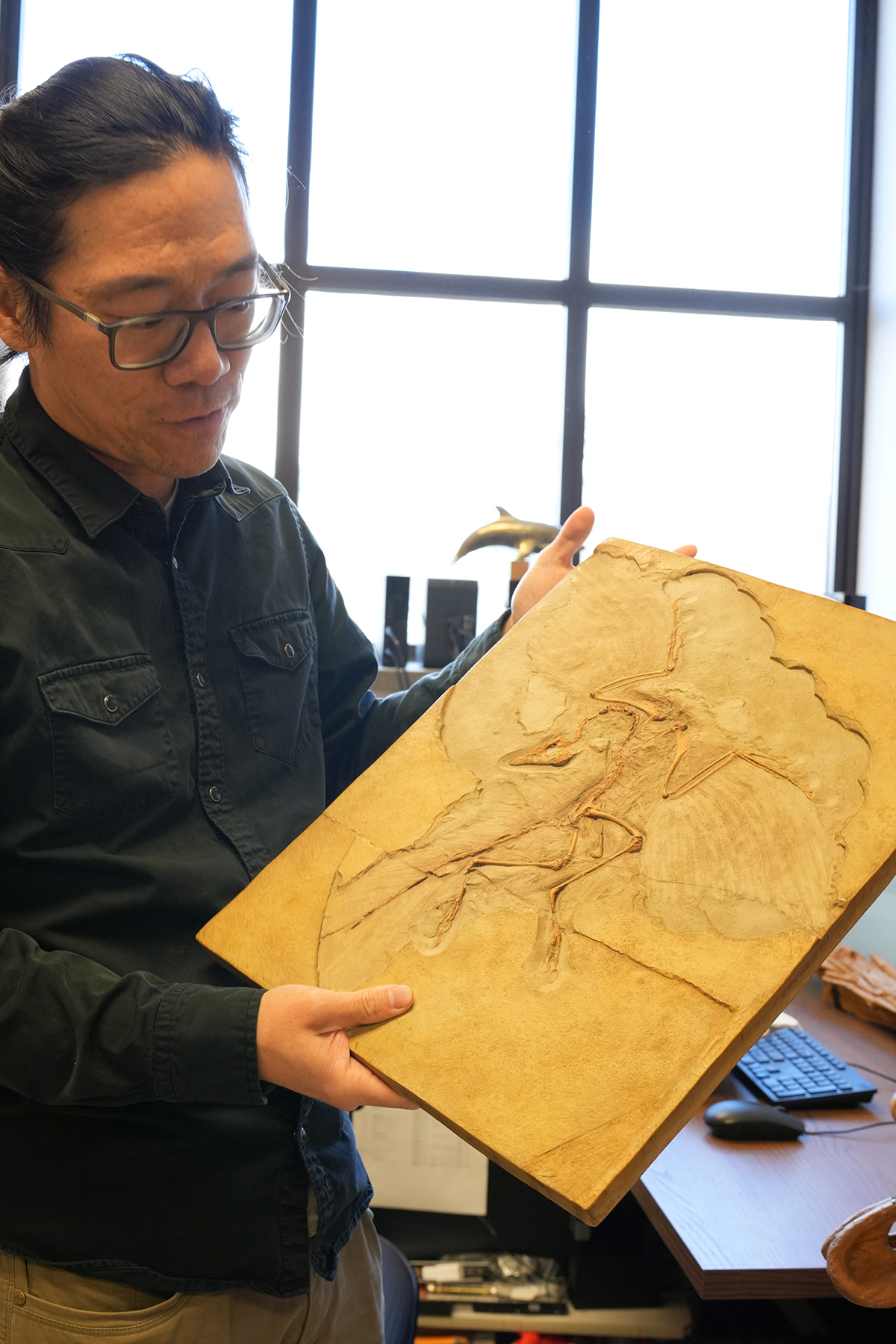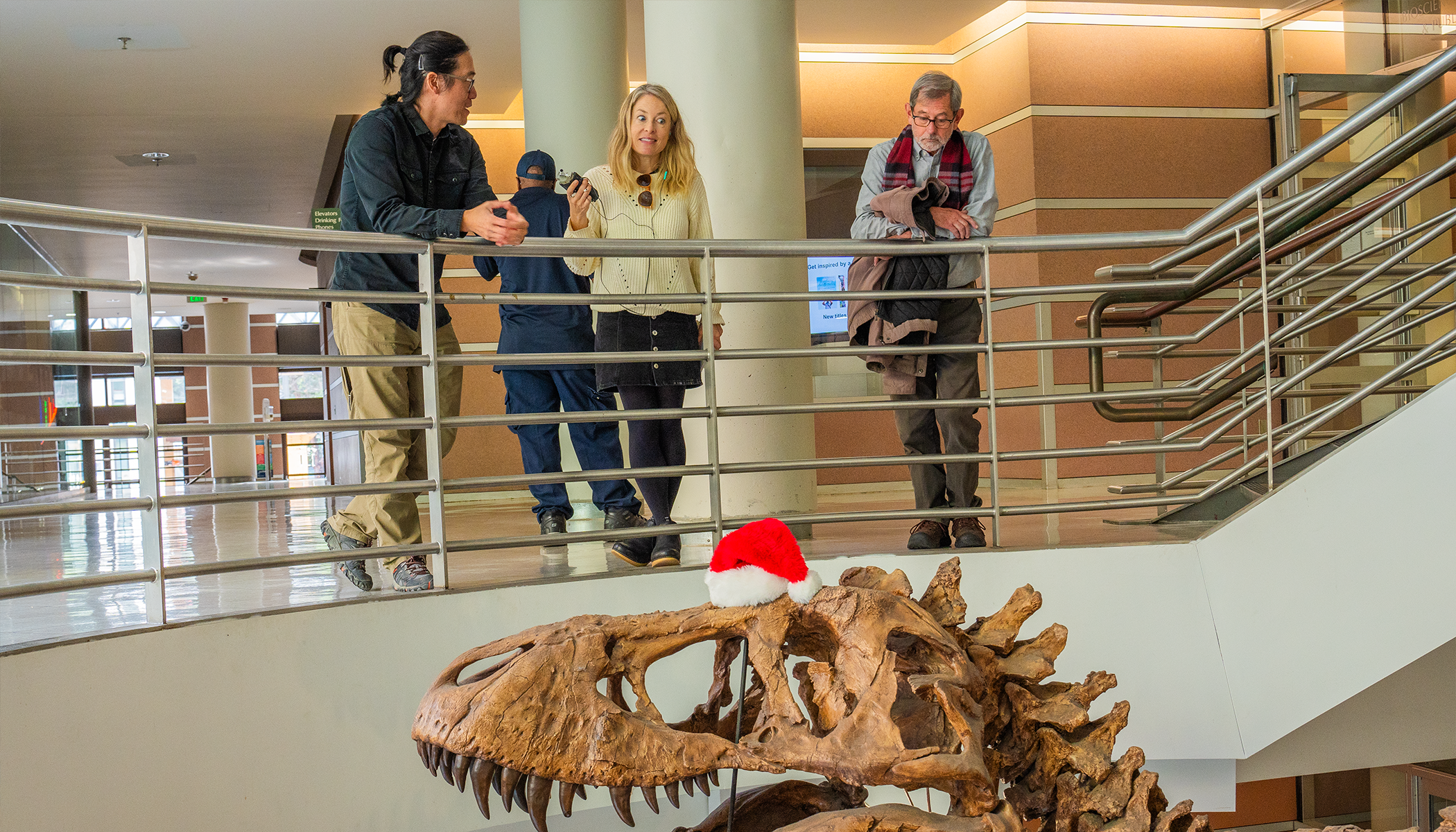Berkeley Voices: Think you know what dinosaurs were like? Think again.
Was the T. rex brightly colored with feathers? Did it run as fast as movies make it seem? How new discoveries challenge our long-held beliefs about the world of paleontology.
December 30, 2024
Key takeaways
- Paleontologists can better understand how dinosaurs and other prehistoric animals looked and lived by studying living animals.
- New discoveries have reshaped what we thought we knew about dinosaurs and the prehistoric world.
- Fossils hold clues about the role of different species of plants and animals during climate change — and the future of Earth.
Follow Berkeley Voices, a Berkeley News podcast about the people and research that make UC Berkeley the world-changing place that it is. Review us on Apple Podcasts.
For UC Berkeley Professor Jack Tseng, the world of paleontology never gets old. With each new discovery, paleontologists like him learn more about the animals that walked the earth millions of years ago.
“If you look at books from 50 years ago, they postured dinosaurs very differently from the way we do it today,” Tseng says. “This constant profusion of new scientific knowledge into the popular psyche is recorded in children’s books, which is a lovely way to see how this science has progressed.”
Fossils also hold valuable clues about our planet’s future and our role within it as we experience climate change, he says.
“The questions we ask of them have to do with how different species sometimes survive, when others go extinct. Paleontology is sort of pre-adapted to plug in to understanding the future of Earth because we have billions of years of the fossil record to learn from.”
This season on Berkeley Voices, we’re exploring the theme of transformation. In eight episodes, we’re exploring how transformation — of ideas, of research, of perspective — shows up in the work that happens every day at UC Berkeley. New episodes will come out on the last Monday of each month, from October through May.
See all episodes of the series.
Anne Brice (narration): This is Berkeley Voices, a UC Berkeley News podcast. I’m Anne Brice.
(Music: “Jubelio” by Blue Dot Sessions)
For a long time, paleontologists thought that the famous, long-extinct apex predator, the Tyrannosaurus rex, may have chased its prey at high speeds. Children’s books and movies often showed them sprinting at a terrifying pace; you might remember scenes from the 1993 film, Jurassic Park, in which a massive T. rex chases characters who are escaping in a Jeep that they’re driving as fast as it can go.
(Music fades down)
Man’s voice: Come on, come on, come on! We gotta get out of here! Now! Now! Right now!
(Sounds of feet running in mud)
Man’s voice: Start the engine!
(T. rex roars loudly)
(Music comes back up)
Anne Brice (narration): But in the past few decades, paleontologists have found that this wasn’t exactly accurate — and it’s one of a number of ideas we’ve long held about these ancient creatures that are being reshaped by modern science.
Jack Tseng: After really sort of ground truthing, (Music fades out) figuring out how much bone and tissue needs to be on the animal to reach a particular speed with enough power, people realized Tyrannosaurus probably didn’t run more than 20, 25 miles per hour.
Anne Brice (narration): Jack Tseng is a UC Berkeley vertebrate paleontologist and functional morphologist. He studies the relationship between an organism’s physical structure and its function in the environment.
He says paleontologists figured out that T. rexes were actually kind of slow compared to what they once thought by studying living bipedal birds, like chickens and ostriches.
Because paleontologists can’t study the soft tissue of extinct animals — for example, their muscles or their digestive physiology — they rely instead on living animals, like birds, crocodiles and mammals to provide clues.
Jack Tseng: Paleontologists have to have one foot in the living world and sort of look at how animals today function. So we have a lot in common with people who study the engineering of animals — the biomechanics of animals; the kinematics — the movements of animals.
(Music: “Vegimaine” by Blue Dot Sessions)
Anne Brice (narration): The more paleontologists learn and discover, the more their understanding of how dinosaurs lived changes and transforms.
In the past few decades, with the advance of imaging technology and the ability to share research across the globe, paleontologists have made leaps in their knowledge of prehistoric animals. It’s changing the popular images we hold about what dinosaurs looked like and how they lived.
And those findings, Tseng says, also hold powerful lessons for what it means to imagine our earth millions of years in the future.
(Music comes up, then fades out)
In the Department of Integrative Biology, associate professor Tseng teaches a handful of classes related to paleontology, including Life During the Age of Dinosaurs.
One of his lectures is about sauropods — you know, the huge, plant-eating dinosaurs with the super long necks. In the lecture, Tseng discusses a working recent hypothesis about how these gigantic animals, the biggest to ever walk the earth, were able to take in adequate oxygen through their necks, which could reach lengths of up to 50 feet.
Jack Tseng: And it really started with looking at animals that were doing extreme things, whether it’s birds or mammals — cheetahs having to run really fast or antelopes having to run really fast. You know, how do animals adapt physiologically to needing this kind of elevated air supply?
Anne Brice (narration): And they found that many birds — the only living dinosaurs today — have hollow bones not just to make them lighter for flight, but also around their lungs, allowing them to expand their aerobic capacity more than they could otherwise.
And sauropods had a similar hollowness in the bones of their vertebral columns, which many paleontologists now believe acted as, kind of, pseudo lung systems, helping them get enough oxygen down their necks all the way to their lungs.
Jack Tseng: There are these, more examples of how we can really start to conclude some seemingly impossible inferences about extinct animals just by understanding how living animals work, really sort of creating this bridge from biology to paleontology.
So in some ways, you know, we can sort of make conjectures about a more specialized breathing system in sauropods. But in some ways we also do not know exactly how they functioned because there’s, in many cases, no living analog.
We sort of walk this fine line of inferring extinct lifestyles based on what we know. But sometimes also animals go beyond modern limits, so that’s still very much a black box for a lot of paleontology.
(Music: “TwoPound” by Blue Dot Sessions)
Anne Brice (narration): At his office in the campus’s Valley Life Sciences Building, Tseng is showing me and a colleague of mine who writes a lot about dinosaurs, Bob Sanders, some fossil replicas that Tseng uses in his teaching.
Bob Sanders: This guy just crops and swallows, whereas that crops and chews?
Jack Tseng: Yes, exactly. So two different solutions to dealing with vegetation.
Anne Brice (narration): The building houses the university’s Museum of Paleontology. It holds one of the largest paleontological collections of any university museum in the world.
Jack Tseng: So this is one that’s pretty popular in children’s books, the diplodocus. This is one of the large dinosaurs. We don’t have the whole skeleton. We have an example of the skull. And you wouldn’t be able to tell the size of the whole animal from the skull because these dinosaurs, sauropodomorph dinosaurs, the largest of the dinosaurs, tend to have small heads for their body size. So the head itself can be deceiving … (audio fades down)
Anne Brice (narration): While most of the collection is open only for research, there is a huge replica of a T. rex in the lobby right when visitors walk in. It’s one of the most complete T. rex skeletons ever reconstructed. This replica is nicknamed Osborn.
Jack Tseng: This specimen was originally discovered in Montana in the Hell Creek formation, which is a rock formation that’s famous for producing lots and lots of dinosaurs … (audio fades down)
(Music fades out)
Anne Brice (narration): In a lot of books, most dinosaurs look kind of like dull-colored giant lizards. They’re often scaly, in muted shades of brownish green.
But in the past several decades, says Tseng, paleontologists around the world have uncovered dinosaur bones with feathers around them, representing species they didn’t realize were feathered before, including tyrannosaurs, the group of predatory dinosaurs that the T. rex belonged to.
Jack Tseng: You will see, in some paleoartistic reconstructions, furry T. rex. That may or may not have been true for all life stages for a T. rex, for example, but we think it’s likely that at least at one point in their lives, they probably had a body that was partially or completely covered in feathers. So that fundamental change in how we think about the appearance of dinosaurs really started with on-the-ground field research-based discoveries.
Anne Brice: Wow, that’s crazy. I mean, it changes how I think about them, you know?
Jack Tseng: Yeah. Yeah. And there’s now ongoing research into not only, you know, what types of feathers cover some of these dinosaurs, but also the coloration. Imagining dinosaurs not as the scaly reptilian animals, but I mean, they are reptiles, but additionally, maybe they were more like modern birds, you know, which are among the most extravagant animals, in terms of the types of colors and feather shapes and sizes they can sport on their bodies.
So it really brings the biology back into what used to be a very sort of a bone-and-death-centered field, which is now these animals are long dead and we only look at their bones, with soft tissue preservation, like skin, and in other cases, feathers, that we can start to literally flesh out these animals.
(Music: “Syriah” by Blue Dot Sessions)
Anne Brice (narration): To complicate our image of the T. rex even more, some researchers posit that T. rexes were actually scavengers instead of active hunters, based in part on the preservation of tooth bite and scratch marks on fossils of their potential prey. Tseng has studied the bite mechanics of Jane, a juvenile Tyrannosaurus rex, to learn more about the forces involved in biting prey.
(Music fades down)
Jack Tseng: I think there’s no doubt that these animals were carnivores. They probably were not eating vegetables, but they were eating the vegetarians.
Modern scavengers, as we understand them, tend to go for carcasses, and they’re not really fresh oftentimes. So they’re either decomposing or really sort of hardened because of the sort of jerky, naturally jerky. And that involves different forces and sort of sharpness of the teeth vs. active predator going after moving prey and potentially having access to fresh tissues. So those different behaviors would change how the teeth were potentially used, what kind of adaptations it would have required for them to do those things.
(Music comes back up)
Anne Brice: Oh, my gosh, if they didn’t hunt and they were scavengers, that would blow everyone’s mind.
Jack Tseng: Yeah. That would be very disappointing for a lot of kids.
Anne Brice: Every kid in the world is like “Aahhh!”
(Music comes up, then fades down)
Jack Tseng: I think paleontology is unique among the sciences in that this shift over the years, over the decades and centuries, of sort of evolving paleontological knowledge is not only captured in a scientific record, it’s also captured in the popular record.
If you look at books from 50 years ago, they postured dinosaurs very differently from the way we do it today. And it’s this constant sort of profusion of new scientific knowledge into the popular psyche that really is recorded in children’s books, which is a lovely way to sort of see how this science has progressed.
The dinosaurs are still the same dinosaurs, but the way we understand them as living animals has changed dramatically over the past several decades.
(Music comes up, then fades out)
Anne Brice (narration): In November, paleontologists in Siberia made a ground-breaking discovery: They unearthed the first-known mummy of a saber-toothed cat. It’s a 3-week-old cub from the ice age.
Although it’s missing its bottom half and hadn’t developed its canine teeth yet, it’s a remarkable find, says Tseng. By studying its soft tissue, scientists can glean clues about the relationship between where the muscles and skin sit relative to the bone, and how that might have shaped its movements, like its hunting style.
Jack Tseng: It’s really, in a sense, a quantum leap in information content. All it takes is one amazing specimen to blow our minds, so to speak.
And that, to me, remains the allure of paleontology is, despite all the technology we have today — which is great — to really take a fresh look at what we already have in our collections, there is still importance in fieldwork. In that sense, we still do fieldwork in very much the same ways as paleontologists did fieldwork 100 years ago.
We don’t have, you know, scanners where we can just say, “OK, I know exactly where the fossils are underground and we’re just going to dig in one spot.” It still takes years of experience, it still takes a heavy dosage of luck to even find any fossil, let alone mummies and incomplete skeletons.
So I think that’s a very sort of equalizing part of paleontology is, if you put in the effort, if you just put in your time, anybody, from the beginning, from a vocational paleontologist to a professional paleontologist, anybody can make amazing discoveries.
(Music: “Gallant Fantasie” by Blue Dot Sessions)
We are naturally curious about the world around us, and especially if it’s something that can seem so alien because these are gigantic or rarely shaped animals, on land and in the ocean, that we no longer have today.
But on the other hand, they actually lived, breathed and eventually died on the same planet that we call home today. So there is that just fundamental thirst for understanding our place on this planet and what came before us.
(Music comes up, then fades out)
Anne Brice (narration): Tseng says there are also increasingly practical aspects of paleontology that can be applied to what we’re facing as a species today with climate change.
In paleontology, everything has already happened, he says. Dinosaurs and other animals and many plants went extinct, and it’s recorded in the rocks for us to study. We know the outcomes of evolutionary history.
But, he says, we don’t necessarily know how they got to that point. And fossils — of vertebrates, like dinosaurs, fish and mammals, but also especially of plants and invertebrates, like mollusks — hold a lot of these clues.
Jack Tseng: The questions we ask of them have to do with how different species sometimes survive, when others go extinct. How they adapt to environmental changes, you know, warming and cooling cycles, habitat disturbances, or dispersals of species from one continent to another.
All of these are also similar questions that today global change biologists are trying to answer is, How do we understand the role of species in different environments? So in a way, paleontology is sort of pre-adapted to plug in to understanding the future of Earth because we have billions of years of the fossil record to learn from.
Anne Brice: Hm-mm. For me, learning about how frogs can adapt to different changes in temperature in the water or these different ways that animals have been adapting … it makes me, even if humans die out, which I’m assuming we probably will, but it makes me hopeful that the animals will survive and that the earth will continue.
Jack Tseng: I agree with you, Anne.
(Both lightly laugh)
One part of me sort of is imagining a future where, if indeed the human species goes extinct, I hope that paleontology does not go extinct, so future paleontologists, not the human species, maybe another species, will someday look back and see our fossil record — the tiny slice of time in which our species lived on this earth.
And it makes you think about what they are going to see when all is said and done. Are they going to see a species that drove ourselves to extinction? Are they going to see one that actually managed somehow to coexist with other life on Earth, maybe even improving things and creating new biodiversity?
That, to me, is kind of sobering to think about, and the fact that even though today, as far as we know, the human species is the only one capable of doing science, recording history, essentially taking a record of what has happened around us, what we’re doing to change the world around us, we may be the first one on this planet, but we might not be the last.
(Music: “Dirtbike Lovers” by Blue Dot Sessions)
Anne Brice: Wow, that’s really cool to think about.
Anne Brice (outro): I’m Anne Brice, and this is Berkeley Voices, a UC Berkeley News podcast from the Office of Communications and Public Affairs at UC Berkeley. This was the third episode of our eight-part series on transformation. New episodes of the series come out on the last Monday of each month.
We also have another show, Berkeley Talks, that features lectures and conversations at UC Berkeley. You can find all of our podcast episodes with transcripts and photos on UC Berkeley News at news.berkeley.edu/podcasts.
(Music comes up, then fades out)
Read more about paleontological research at UC Berkeley:
